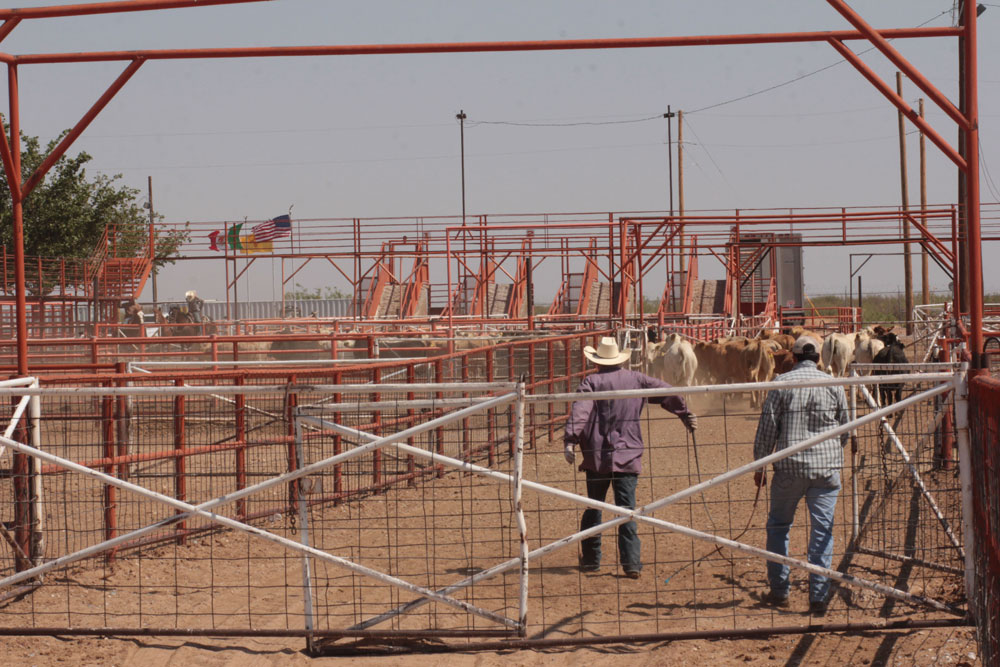SANTA TERESA, N.M. – Life in the borderland, as the greater El Paso-Ciudad Juárez area is called, isn’t always easy. But there’s a place west of the metropolitan area along the U.S.-Mexico border that has found a balance.
It’s the rare kind that involves a lot of dirt, a little political red tape and a few moos.

Cattle herders help push livestock into trailer trucks for shipment to other parts of the U.S. (Jasmine Aguilera/Borderzine.com)
Cattle come and go from one country to the other at the Santa Teresa International Export/Import Livestock Crossing in southeastern New Mexico. The site is one of two along the New Mexico-Chihuahua border, and the exchange of livestock involves regulation from such agencies as the U.S. Department of Agriculture, the U.S. Food and Drug Administration, SAGARPA (the Mexican equivalent of the USDA) and customs offices of both countries.
Daniel Manzanares, the director of the facility, calls his operation the safest port of entry along the 1,954-mile international border.
The exchange of livestock in a controlled and enclosed area often visited by government officials is in stark contrast to what humans must go through to get to the United States. Manzanares said he feels that people not familiar with border operations buy into media reports of crime and death and drug cartels.

Daniel Manzanares, director of the Santa Teresa International Livestock Crossing, oversees hundreds of cattle crossings between Mexico and the U.S. each year. (Jasmine Aguilera/Borderzine.com)
“They don’t want to hear ‘Oh yeah, it’s perfectly safe and it’s a very good organization, it’s a very safe operation.’ That’s not news,” Manzanares said. “They want to hear 49 people were beheaded in Matamoros or something. Those are the kinds of things that freak people out.”
Manzanares acknowledges the effect of the drug cartels in Mexico, but places plenty of blame on Americans for their desire for illegal drugs.
“If the demand was not here in the United States, there’d be no problems. Americans need to start looking at ourselves,” he said. “We need to start looking at ourselves and saying ‘how are we causing this?’ Americans still don’t want to look in the mirror and understand that we’re a huge cause, big part of the unrest that’s happening in that country (Mexico).”
But the only unrest at the livestock crossing is the dirt and hay kicked up by farm vehicles, cowboys on horses and cattle walking or trotting from pen to pen or from Mexico to the U.S.
Crossings happen almost daily, monitored by perhaps a single U.S. Border Patrol vehicle. Most cattle come into the U.S.; only a small percentage are exported to Mexico as breeder livestock.
“We’re currently at 190,888 animals (in 2012), so we’re doing very well,” Manzanares said Monday. “And we’ve been closed 12 times for this little disease that’s been happening. “
It’s a “little” disease with a big name – bovine papular stomatitis – that leads to some cattle being quarantined.
That disease is similar to a common cold, Manzanares said, but because symptoms resemble the more serious hoof and mouth disease, the USDA stops the crossings until bacteria samples from the cattle can be tested. It’s usually only a few days before crossings resume.
The process of moving cattle from one side to the other involves determining which parties need livestock, grouping that livestock by name of the person receiving an order of cattle and herding the livestock into pens before it is shipped in trailer trucks.


